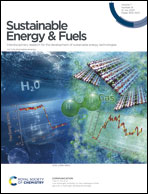Tuning the oxidation state of SnOx and mass transport to enhance catholyte-free CO2-to-formate electrolysis†
Abstract
Electrochemical CO2 conversion to formate is a promising potential pathway to facilitate carbon neutrality with industrial feasibility. However, designing an active catalyst and optimizing the CO2 electrolyzer to enable energy-efficient CO2 conversion is a continuing challenge. Herein, we demonstrate that the initial surface oxidation state of tin oxide (SnOx) catalysts is a key and enduring factor in determining the CO2-to-formate conversion efficiency. Comparing the selectivity and energy efficiency of formate generation on thermally-evaporated and annealed SnOx catalysts reveals that catalysts that are initially SnO-rich at the surface show improved overall efficiency relative to catalysts that are initially SnO2-rich. Moreover, we show that controlling the flow rate of CO2 strongly affects overall CO2-to-formate conversion activity in partially-concentrated CO2 streams in a catholyte-free electrolyzer, which emphasizes the importance of mass transport of CO2 to design an efficient CO2 electrolyzer. These findings provide insights into the critical importance of the chemical state in non-stoichiometric transition metal oxide catalysts like SnOx catalysts and CO2 mass transport for CO2-to-formate conversion, offering fundamental guidelines and an efficient carbon-negative CO2 conversion.



 Please wait while we load your content...
Please wait while we load your content...
